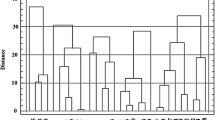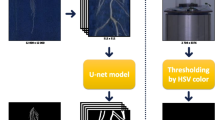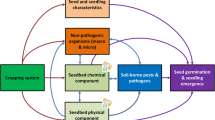Abstract
The identification of the genotypic and environmental factors responsible for the genotype by environment interaction is essential in any breeding program. A Multi Environmental Trial (MET) including 3 years, 3 locations and 14 lines of spring triticale (× TriticosecaleWittmack) was carried out in a Mediterranean environment (Sardinia, Italy). Water available to the crops was calculated through a model run with the environmental variables and the phenological data recorded in each environment. Yield, yield components and heading date were used to perform an Additive Main effects and Multiplicative Interaction (AMMI) analysis. Interaction for yield was relevant only in 2 environments out of 8, one characterised by a late sowing, the other by the warmest pre-anthesis period. Correlations between Interaction Principal Component Axis (IPCA) scores and environmental and genotypic variables showed that genotype by environment interaction for yield and kernels per m2 is related to interaction for phenology but not to the yield level. Yield level was significantly correlated with the water availability. Genotype by environment interaction for yield is mainly determined by thermal conditions in the pre-anthesis period, genotypic photoperiodic sensitivity and sowing time.
Similar content being viewed by others
References
Aggarwal, P.K., A.K Singh, G.S. Chaturvedi & S.K. Sinha, 1986a. Performance of wheat andtriticale cultivars in a variable soilwater environment. II Evapotranspiration, water use efficiency, harvest inde × and grain yield. Field Crops Res 13: 301–315.
Aggarwal, P.K., G.S. Chaturvedi, A.K. Singh & S.K. Sinha, 1986b.Performance of wheat and triticale cultivars in a variable soilwater environment. III. Source - sink relationships. Field Crops Res 13: 317–330.
Aggarwal, P.K., M.J. Kropff, R.B. Matthews & C.G. McLaren, 1996. Usingsimulation models to design new plant types and to analyse genotype by environment interactions in rice. In: M. Cooper & G.L. Hammer (Eds.), Plant Adaptation and Crop improvement, pp. 403–418. CAB International, UK.
AgronomixSoftware Inc., 1997. Agrobase. User's guide & Command Reference. Agronomix Software Inc., Canada.
Amir, J. & T.R. Sinclair, 1991a. A model of the temperature and solar radiation effects on spring wheat growth and yield. Field Crops Res 28: 47–58.
Amir, J. & T.R. Sinclair, 1991b. A model of water limitation on spring wheat growthand yield. Field Crops Res 28: 59–69.
Ball, S.T., D.J. Mulla & F.K. Calvin, 1993. Spatialheterogeneity affects variety trial interpretation. Crop Sci 33: 931–935.
Bidinger, F.R., G.L. Hammer & R.C. Muchow, 1996. The physiological basis of genotype by environment interaction in crop adaptation. In: M. Cooper & G.L. Hammer (Eds.), Plant Adaptation and Crop Improvement, pp. 329–364. CAB International, UK.
Bidinger, F.R., V. Mahalakshmi, B.S. Talukdar & G. Alagarswamy, 1982. Improvement ofdrought resistance in pear millet. In: Drought Resistance in Crops with Emphasis on Rice. pp. 357–375, IRRI, Los Banos, The Philippines.
Blum, A. & Y. Pnuel, 1990. Physiological attributes associated with drought resistance ofwheat cultivars in a Mediterranean environment. Aust J Agric Res 41: 799–810.
Bradford, K.J., 1994. Waterstress and the water relations of seed development: a critical review. Crop Sci 34: 1–11.
Chowdhury, S.I. & I.F. Wardlaw, 1978. The effect of temperature on kernel development in cereals. Aust J Agric Res 29: 205–223.
Cooper, M. & G.L. Hammer, 1996. Plant Adaptation and Crop Improvement. CAB International, UK.
Cooper, M., P.S. Brennan & J.A. Sheppard, 1996. A strategy for yield improvement of wheat which accommodates large genotype by environment interactions. In: M. Cooper & G.L. Hammer (Eds.), Plant Adaptation and Crop Improvement, pp. 487–511. CAB International, UK.
Denis, J.B., 1988. Two-way analysis using covariates.Statistics 19: 123–132.
Fischer, R.A., 1979. Growth and water limitation to dryland wheat yield in Australia:a physiological framework. J Aust Inst Agric C 45: 83–94.
Gauch, H.G., Jr, 1992. Statistical Analysis ofRegional Yield Trials: AMMI Analysis of Factorial Designs. Elsevier, The Netherlands.
Giunta, F., R. Motzo & M. Deidda, 1993. Effect of drought on yield and yield components of durum wheat and triticale in a Mediterranean environment. Field Crops Res 33: 399–409.
Giunta, F., R. Motzo & M. Deidda, 1999. Grain yield of atriticale ( × Triticosecale Wittmack) collection grown in aMediterranean environment. Field Crops Res 63: 199–210.
Laroche, G. & P. Gate, 1996. Some physiological features of triticale and their consequences on cropmanagement in France. In: H. Guedes-Pinto, N. Darvey & V.P. Carnide (Eds.), Triticale: Today and Tomorrow, pp. 737–741. Kluwer Academic Publishers, The Netherlands.
Ritchie, J.T., 1991. Wheat phasic development. In:J. Hanks & J.T. Ritchie (Eds.), Modelling Plant and Soil Systems, pp. 31–54. ASA, Wisconsin, USA.
Shorter, R., R.J. Lawn & G.L. Hammer, 1991. Improving genotypic adaptation in crops-A role for breeders,physiologists and modellers. Expl Agric 27: 155/175.
Slafer, G.A. & R. Savin, 1991. Developmentbase temperature in different phenological phases of wheat (Triticum aestivum). J Exp Bot 42: 1077–1082.
Stroup, W.W., P.S. Baenziger & D.K. Mulitze, 1994. A comparison of methods to account for spatial variation inwheat yield trials. Crop Sci 34: 62–66.
Van Eeuwijk, F.A., J.B. Denis & M.S. Kang, 1996.Incorporating additional information on genotypes and environments in models for two-way genotype by environment tables. In: M.S. Kang & H.G. Gauch (Eds.), Genotype-by-Environment Interaction, pp. 15–49. CRC Press, Boca Raton, FL.
Vargas, M., J. Crossa, K. Sayre, M. Reynolds, M.E. Ramirez & M. Talbot, 1998. Interpreting genotype× environment interaction in wheat using partial least squares regression. Crop Sci 38: 679–689.
Vargas, M., J. Crossa, F.A. van Eeuwijk, M.E. Ramirez & K. Sayre, 1999. Using Partial Least Squares Regression,Factorial Regression, and AMMI Models for interpreting genotype × environment interaction. Crop Sci 39: 955–967.
Wallace, D.H., K.S. Yourstone, J.P. Baudoin, J. Beaver, D.P. Coyne, J.W. White & R.W. Zobel,1995. Photoperiod × temperature interaction effects on the days to flowering of bean (Phaseolus vulgaris L.). In: M. Pessarakli (Ed.), Handbook of Plant and Crop Physiology, pp. 863–891.
Author information
Authors and Affiliations
Rights and permissions
About this article
Cite this article
Motzo, R., Giunta, F. & Deidda, M. Factors affecting the genotype × environment interaction in spring triticale grown in a Mediterranean environment. Euphytica 121, 317–324 (2001). https://doi.org/10.1023/A:1012077701206
Issue Date:
DOI: https://doi.org/10.1023/A:1012077701206




